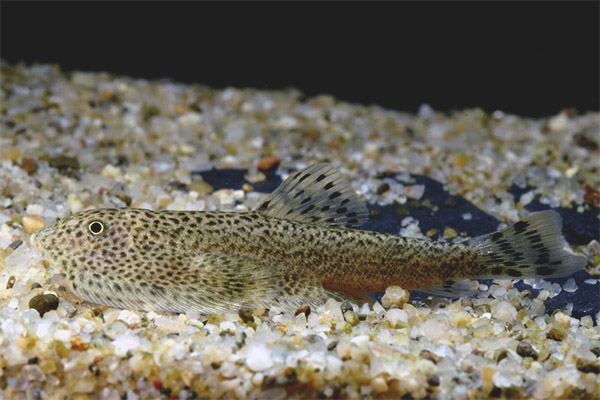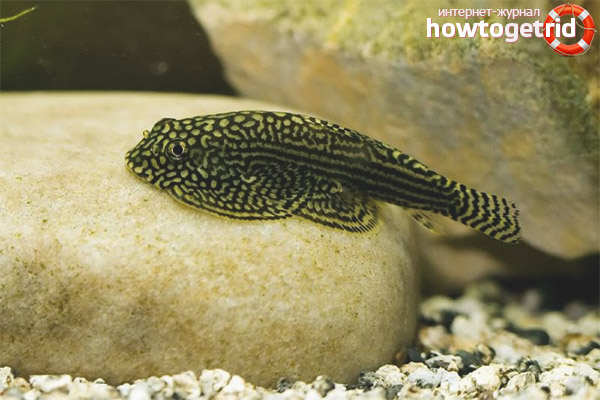The content of the article
The original Beafortia fish has the Latin name Beaufortia kweichowensis. In appearance it resembles a sea flounder. Sometimes beefortia is called a pseudo scat. The size of the fish is about 8 cm. Anyone who sees it at least once will definitely be interested.
Beefortia has a light brown color. There are dark spots all over the body. There is also a spotty line on the edge of the fins. In nature, its habitat are fast waters. Usually the bottom in these waters is rocky. But the fish is well adapted to these conditions. It does not show aggression, so it can not fight with predatory fish. But the ability to develop high speed often saves her from them.
Beefortia has good stamina. She can live in different conditions. But the most natural environment for her is cool, fast waters, in which she is used to living in nature.She was accustomed to withstand the rapid flow, to hide in various shelters. It eats the bloom that forms on the rocks and decor of the aquarium. By nature, it belongs to the gregarious fish. Therefore, it is best to keep them in several pieces. It is better if it is a group of 5-7 fish.
Habitat in nature
The main habitat of the fish is fast rivers or streams of shallow depth. The soil in these waters is usually sandy or stone. Due to the fact that the soil at the bottom is solid, and the flow is very fast, there is very little vegetation in these rivers. Often at the bottom of a lot of fallen leaves. Like so many fish that belong to the loach, the Befortis love water that is saturated with oxygen. Food for them are algae and various microorganisms.
Description
The length of the befort can reach 8 cm, but with an aquarium content their size is usually smaller. Lives fish for about 8 years. It has a flat stomach, small height. In appearance it is very similar to flounder. Many people mistakenly believe that she belongs to the catfish. But beefortia is in fact a representative of the loach species. They have a light brown color. The appearance of the fish is rather difficult to describe, as it looks unusual. Therefore, to understand how it looks, you need to see it.
Content issues
If a representative of this species is kept in the right conditions, it will be quite enduring. But for those who do not have experience in maintaining an aquarium, it is better not to choose beforty. This fish needs water to be as clean and cool as possible. In addition, she has no scales. This makes beofortia susceptible to diseases and many drugs.
Feeding
In nature, its food is various algae, as well as microorganisms. Feed it when kept in an aquarium should be live food or algae. Live foods are sold frozen. For a fish to be healthy, it needs to buy only high-quality food. In addition, vegetables should be present in the diet, as well as a pipe maker, bloodworm and daphnia.
Content
Mostly these fish live on the very bottom of the aquarium, but they will swim out in order to eat the growths that have formed on the aquarium walls. To contain representatives of this species, it is enough to have a medium-sized aquarium. The minimum size is 100 liters. In the aquarium should be a lot of plants and other items that can serve as shelter. For example, stones, caves or snags.
The quality of the soil is best suited sand, but you can use gravel. It should be soft and not have sharp edges. The fish will live in water with different characteristics, but low-acid water having a low level of hardness is best suited for it. It is important that its temperature is in the range of 20-23 degrees. Since the beeforties live in cool water, when the temperature rises in the aquarium, the fish will feel very uncomfortable. If the room is hot, the water must be cooled.
An important condition is also that the water was clean. It should be a lot of oxygen. It is important to remember that representatives of this species usually live in reservoirs with a rapid current. Therefore, it is desirable that the water in the aquarium most consistent with these parameters.The flow can be created by placing a high power filter.
In the aquarium you need to put as much as possible of the logs and stones that can serve as a shelter for it. To algae grow well, you need to install a source of bright light. But shaded areas are also needed in the aquarium.
If you purchase beofortia, it is advisable to buy several individuals at once (about 4-5). If they live in a group, their behavior will unfold better. If you get one or two fish of this species, then they will swim only to eat. The rest of the time they will spend in the shelter. Frequent fights are possible among males, as they tend to defend their territory. But usually they do not injure each other, but only expel the opponent from the territory.
Compatibility
This view can be called quite livable. They do not show aggression against the neighbors in the aquarium. It is best to hook them to the fish, which also love the flow and water not higher than 23 degrees.
Sex differences
Breeding
There is practically no information about artificial breeding of befortia. There are only a few messages. Those fish that are sold in pet stores are caught in nature.
Health
Due to the fact that representatives of the species do not have scales, they are susceptible to disease. When placing in new environmental conditions, care should be taken. In addition, these fish are sensitive to many drugs.
Video: beefortia aquarium fish












To send